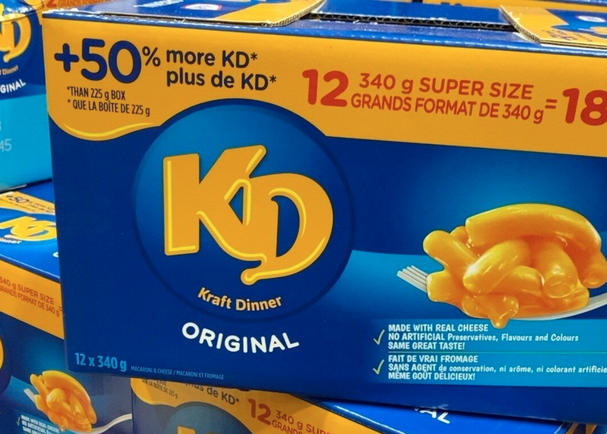|
Written by Henry Liu Canadians are one of the largest consumers of Kraft Dinner macaroni and cheese in the world, buying more than one fifth of all global Kraft Dinner sold in a week. The food can be said to have achieved national food status in Canada. Paul Martin’s wife described Kraft Dinner as the former Prime Minister’s favourite food. The term “Kraft Dinner” itself has entered into use as a proprietary eponym (similar to how “Kleenex” has become synonymous with any facial tissue) by many Canadians, often being used to describe all boxed macaroni and cheese products. It’s little wonder Kraft Dinner and other non-perishables are among the most donated items to food banks, being one potential food source for the hundreds of thousands of food-insecure people who use food banks in Canada every year.
Food holds cultural, symbolic, and emotional meaning for many people all over the world. Many Canadians have shared priorities regarding food, including quality, nutrition, and ethics. However, there is a disconnect between the perspectives of food-secure and food-insecure individuals that reveals the lack of understanding of many food-secure Canadians on the realities of living with food insecurity. Differing views on Kraft Dinner is one small aspect through which this disconnect can be examined. Many food-secure Canadians see Kraft Dinner as well-suited for donation to food banks. From its reputation as a comfort food, Kraft Dinner is considered as being a palatable food that anyone can enjoy, especially children. The perceived palatability is enhanced by the fact that Kraft Dinner is sold as a DIY kit that is cooked and prepared at home, as compared to pre-cooked or canned foods. Furthermore, the ease-of-preparation of Kraft Dinner, is an additional benefit. There’s the perception that little knowledge and kitchenware are required to create a complete meal with ‘simple’ ingredients of cheese, butter or margarine, and milk. Finally, as a non-perishable and cheap product, Kraft Dinner is considered an ideal meal to donate. For many of the 1.2 million Canadian households experiencing moderate to severe food insecurity, however, Kraft Dinner can have quite different connotations. It can represent an unhealthy food of last resort, purchased from stores or obtained from food banks during periods of financial constraint. Kraft Dinner is often only eaten near the end of the month out of obligation, when money or other foods are near depleted. It is also evident that Kraft Dinner is an unhealthy and nutritionally unbalanced meal, having little dietary fibre and an excessive amount of sodium. Ironically, despite the perception of Kraft Dinner’s simplicity, the ease of obtaining ‘simple’ ingredients like milk is taken for granted by food-secure people, as it is often not available from food banks. Milk and other dairy products are often scarce in food-insecure households, and carefully divided between members of a household (with younger children being given greater priority to meet their nutritional needs). In particular, mothers in food-insecure, single-parent households are commonly compromising their own nutritional intake of milk and other foods (on average consuming less than the recommended dietary allowance of important nutrients like calcium, folate, iron, and zinc) to ensure that the nutritional needs of their children are met. Without milk, Kraft Dinner is often prepared as literally and symbolically ‘incomplete’ meals. The purchasing and receiving of Kraft Dinner from food banks under conditions of financial constraint are a microcosm of the deficits in Canadian social policy regarding food insecurity. Solutions to food insecurity in Canada have been locally-focused and implemented on an ad hoc basis, often focusing on distribution of food through food banks. Although food banks play very important roles in providing immediate food assistance, they do not provide long-term, sustainable solutions. Food banks are unable to address the fundamental problem of household food insecurity: households can’t afford to purchase their own food. Long-term solutions reducing food insecurity in Canada must account for real incomes and the affordability of food. Unlike the United States, Canada currently has no national food assistance program, but rather an informal patchwork of programs. Implementing a national food assistance program is one approach that could help reduce the cost of foods for food-insecure households, particularly foods of important nutritional value (e.g. milk, which is often inadequately consumed in low-income populations). However, this is an incomplete solution, as food expenditures often form the most ‘elastic’ and variable portion of a household’s budget, having lower priority than childcare expenses and shelter/housing expenses. In particular, the lack of affordable daycare presents a significant barrier to employment for households with children. The elimination of food insecurity requires poverty reduction initiatives that address the different deep-rooted and systemic threats to household income. Image Source (CC BY-SA 3.0): https://ca-fr.openfoodfacts.org/cgi/product_image.pl?code=0068100902426&id=front_fr
0 Comments
Your comment will be posted after it is approved.
Leave a Reply. |
Categories |


 RSS Feed
RSS Feed